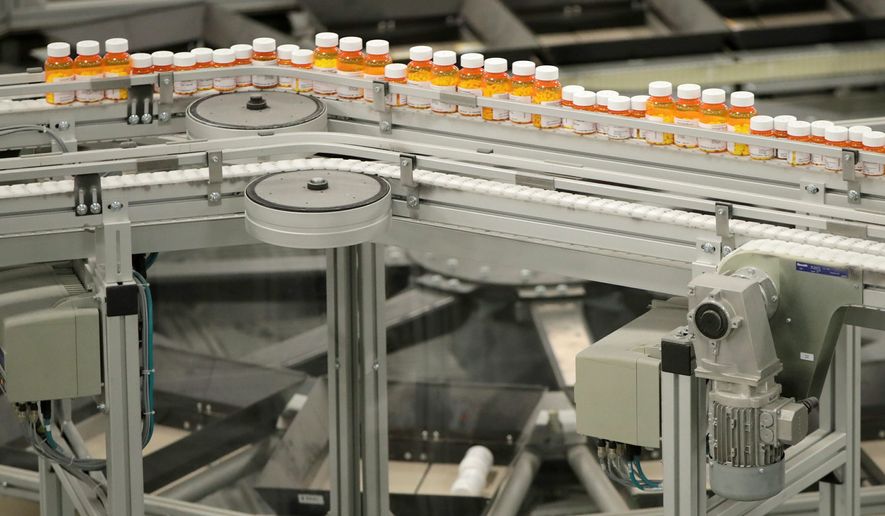Symbicort, an inhaler marketed to people whose lung disease makes them “huff and puff,” rolls off the manufacturing line at a price of $327 for a month’s supply.
A familiar TV ad, in which a little girl compares her grandfather’s cough to the Big Bad Wolf from “The Three Little Pigs,” trumpets the drug’s benefits and advises about side effects but doesn’t mention the list price.
That could change under the Trump administration’s proposed rules that would require companies to disclose the cost in legible print on any video ads.
The pharmaceutical industry is fighting back, arguing that consumers should be able to find the price elsewhere and that few people end up paying the list price anyway.
In the case of Symbicort, some customers pay nothing under AstraZeneca’s “zero pay” program. Seniors on Medicare will shell out varying sums as they move through the year, depending on whether they have surpassed certain spending limits.
Enrollees in suburban Maryland with a SilverScript Choice plan would pay $46 at a CVS pharmacy near the Beltway until they hit Medicare’s “doughnut hole” — when the have spent enough for their government subsidy to shrink and their out-of-pocket cost rises to $82, according to the Medicare Plan Finder portal.
Seniors on the same plan in Seattle would pay $34 per month for Symbicort at a CVS near the Pike Place Fish Market for most of the year.
Given those variables, disclosing list prices alone “would likely serve to confuse patients and potentially deter use of beneficial medicines that may be affordable once other factors, such as insurance coverage, are considered,” AstraZeneca said in a statement to The Washington Times.
The Trump administration says there’s still value in forcing companies to reveal list prices.
People who have high-deductible plans can pay thousands of dollars in drug costs, at list price, before their insurance kicks in. Others pay a percentage of a drug’s cost, so the list price, while not their cost, is still indicative of what they will pay.
“So [the list price] really matters, and as a result, we think disclosure of those list prices will create a downward pressure on the list prices of those drugs and impact Pharma behavior,” Health and Human Services Secretary Alex Azar told Bloomberg Television.
The goal is to give consumers an “anchor price,” the same way car manufacturers give a suggested retail price. While few pay the exact amount, it creates a way to compare deals and shop around.
If patients suddenly stop requesting a drug that costs, say, $11,000 after the TV rule takes effect, it probably won’t cost that much for long, said a senior administration official who was outlining how the plan might work in the real world.
‘The starting point’
Members of the public will have two months to weigh in on the proposal, which applies to any drugs covered by Medicaid and Medicare programs.
Companies would be required to legibly display the wholesale acquisition cost of drugs costing more than $35 for a course of treatment at the end of their TV ads.
In Symbicort’s case, for instance, the list price would appear on screen after the ad narrator ticks off the benefits and side effects of the inhaler for chronic obstructive pulmonary disease, or COPD.
Drugmakers say setting a price is alchemy, with factors such as how effective a drug is in extending or enhancing quality of life and whether it reduces the need for other costly medical services. Affordability is also considered.
Manufacturers say they seek profits in order to invest in the next generation of lifesaving treatments.
“There is no standard method of setting the list price. The manufacturer will basically set the price as high as possible — the term people often use is ‘whatever the market will bear,’” said Stacie B. Dusetzina, associate professor of health policy at Vanderbilt University.
Insurers praised the administration’s proposal, saying lower list prices will result in better deals for their beneficiaries and allow them to keep premiums down.
If a drug starts at an astronomical price, there is only so much that insurers and key middlemen such as pharmacy benefit managers can do to bring it down, they argue.
“The list price drives the entire pricing process — it’s the starting point. Lower list prices will mean lower costs for patients and taxpayers,” said Cathryn Donaldson, a spokeswoman for America’s Health Insurance Plans, a top insurers lobby.
Yet it’s unclear whether the proposal will force market changes.
Whether consumers take action could depend on how they react to hearing the list price along with language that says consumers could end up paying less at the counter.
Although that may give a fuller picture of what happens in the real world, it may not provide the shock value the administration is anticipating to spark patient reactions and stir up competition.
“It clearly depends on what they have to say,” said Gerard Anderson, a professor at the Johns Hopkins Bloomberg School of Public Health. “If they have to say just the list price, people actually pay attention to that and say, ‘I can’t afford it. Why is it so expensive?’”
Pharmaceutical Research and Manufacturers of America (PhRMA), the umbrella group for drugmakers, said consumers are looking for a more nuanced approach.
It pointed to a survey it commissioned that found 61 percent of consumers prefer ads that lead them toward more information, while just 23 percent said they wanted the list prices included in TV spots.
PhRMA said dozens of its member companies have agreed to include information in their TV ads directing consumers to websites that outline list prices and provide context on how rebates, discounts and insurance coverage might affect the cost.
• Tom Howell Jr. can be reached at thowell@washingtontimes.com.




Please read our comment policy before commenting.